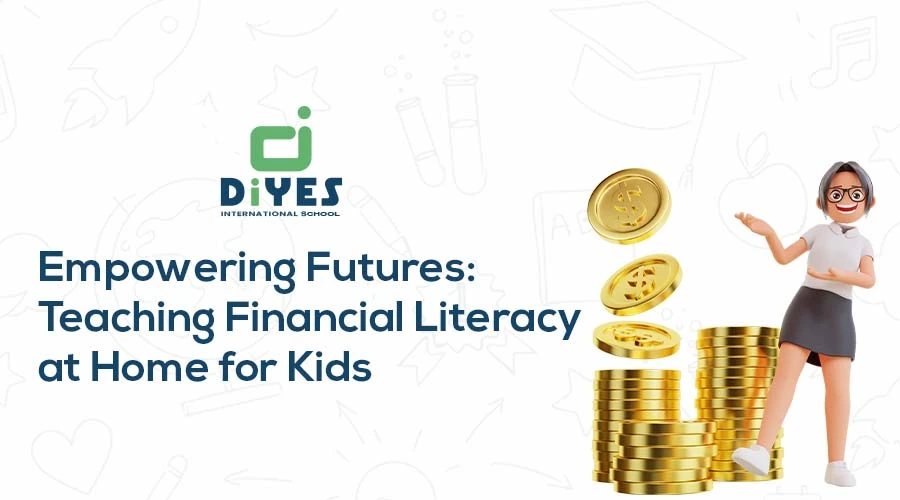In the ever-evolving realm of education, it’s imperative to provide our children with crucial life skills that go beyond the scope of traditional subjects. Teaching financial literacy to children emerges as a vital component, nurturing the groundwork for responsible money management. This blog delves into the crucial importance of imparting financial knowledge to kids and explores practical strategies, challenges, and the long-term impact of early financial education.

This blog navigates the significant role of financial literacy for students at home, unveiling its transformative potential in shaping responsible and informed money habits in children. From introducing basic money concepts to instilling the importance of budgeting and saving, each topic delves into practical strategies while addressing the challenges that come with imparting financial knowledge.
The Importance of Financial Literacy for Kids
Financial literacy stands as a crucial pillar of practical knowledge, offering children a set of invaluable tools for making informed decisions about money. In the journey towards responsible financial behaviour, parents play a pivotal role by introducing age-appropriate concepts that serve as the building blocks for a lifetime of financial well-being. From mastering basic budgeting principles to grasping the significance of saving, these fundamental skills empower children to confidently navigate the intricacies of personal finance.
- Mastering Basic Budgeting: Introducing children to basic budgeting principles forms the bedrock of financial literacy. Parents can kickstart this process by explaining the concept of income and expenses in simple terms. Engaging children in discussions about allocating money for different purposes nurtures an early understanding of budgeting as a tool for managing resources wisely. This foundational knowledge sets the stage for more advanced financial concepts in the future.
- Understanding the Value of Saving: Teaching children the value of saving goes beyond the act of setting money aside. It involves instilling the idea that saving is a deliberate and purposeful choice with long-term benefits. Parents can initiate this lesson by encouraging children to save a portion of their allowances or earnings. This not only cultivates a habit of saving but also introduces the concept of delayed gratification, an essential skill for making thoughtful financial decisions.
- Exploring Smart Spending Habits: Financial literacy extends to cultivating smart spending habits. Parents can guide children in making informed choices when it comes to spending money. By discussing needs versus wants and encouraging thoughtful decision-making, parents help children develop a discerning approach to expenditures. These early lessons lay the groundwork for responsible consumer behaviour and contribute to the development of a mindful attitude towards spending.
- Introducing the Power of Earning: Financial literacy isn’t solely about managing existing resources; it also encompasses understanding the power of earning. Parents can introduce age-appropriate concepts of income generation, such as allowances for completing chores or running a small business like a lemonade stand. This not only teaches the value of effort-based income but also instills a sense of entrepreneurship and resourcefulness.
- Nurturing a Long-Term Financial Mindset: Beyond immediate financial decisions, financial literacy involves nurturing a long-term mindset. Parents can instill the concept of setting financial goals, whether it’s saving for a special toy, a school trip, or even for higher education in the future. By emphasizing the importance of planning for the future, children learn the significance of strategic financial thinking and goal-oriented behaviour.
The introduction of financial literacy to children is an investment in their future. By nurturing smart money habits from a young age, parents lay the groundwork for responsible financial behaviour. From budgeting to saving and making thoughtful spending choices, these skills empower children to navigate the complexities of personal finance with confidence. As we recognize the importance of financial literacy, let us commit to providing our children with the knowledge and tools they need to excel in a financially dynamic world.
Introducing Basic Money Concepts
Instilling a foundational understanding of money in children is not just about teaching them the physical aspects of currency; it’s about building a mindset for responsible financial decision-making. Starting with basic money concepts lays the groundwork for a lifetime of financial responsibility and empowerment.
- Value of Coins and Bills: Exploring the value of coins and bills should involve more than just identification.

Engage children in activities where they understand the relative worth of different denominations. Discussing how these small pieces of metal and paper represent value nurtures an early appreciation for the concept of money.
- Needs vs. Wants: The distinction between needs and wants is a fundamental aspect of financial literacy. Create scenarios that encourage critical thinking—ask questions like, “Is a toy a need or a want?” This not only sharpens decision-making skills but also lays the foundation for responsible spending habits.
- Earning and Spending: Beyond the basic understanding of earning money through tasks, discuss the concept of income sources. Children can learn that people earn money through jobs, entrepreneurial ventures, or investments. Understanding the diverse ways money can be earned broadens their perspective on financial possibilities.
- Counting and Budgeting Games: Make counting and budgeting interactive by turning them into games. Use play money to simulate real-life transactions and budgeting scenarios. This hands-on approach not only reinforces numerical skills but also makes financial concepts more tangible and relatable.
- Real-life Application: The practical application of money concepts is crucial. Whether it’s planning a family outing, saving for a desired item, or contributing to a charity, involving children in real-life financial decisions connects theoretical knowledge to practical scenarios, making the learning experience more meaningful.
By approaching basic money concepts as building blocks for a financial mindset, parents set the stage for a solid foundation in financial responsibility, empowering their children with essential life skills.
Teaching Budgeting and Saving
Budgeting and saving are not just skills; they are life habits that shape financial well-being. Teaching these concepts from an early age involves instilling a sense of purpose and discipline, setting the stage for responsible financial behaviour.
- Allowance System: An allowance system isn’t just about giving children money; it’s a tool for teaching financial planning. Encourage children to allocate their allowance for spending, saving, and sharing. This structure provides hands-on experience in budgeting and nurtures a sense of financial responsibility.
- Goal-oriented Saving: Saving gains significance when tied to specific goals. Encourage children to set savings goals, whether it’s for a toy, a game, or a future event. This not only makes saving more purposeful but also teaches the value of delayed gratification and long-term planning.
- Hands-on Experience: Practical experiences that involve budgeting and saving, such as planning a family outing, provide children with tangible examples of financial decisions. Experiencing the outcomes of their choices reinforces the link between responsible money management and enjoyable experiences.
- Understanding Trade-offs: Teaching children about trade-offs—choosing between spending on one thing over another—builds a fundamental understanding of opportunity cost. This concept helps children make more thoughtful choices and understand the consequences of their financial decisions.
- Financial Responsibility Discussions: Engaging in age-appropriate discussions about financial responsibilities, such as paying for goods and services, introduces children to the concept of financial accountability. These conversations help them understand the broader implications of financial decisions in daily life.
Teaching budgeting and saving is not just about numbers; it’s about cultivating discipline, purpose, and a forward-thinking approach to finances, empowering children with essential life skills.
Engaging in Real-life Money Experiences
Real-life money experiences transcend theoretical knowledge, providing children with practical insights into financial decision-making. Integrating these experiences into daily life enhances their understanding of money management.
- Grocery Shopping Lessons: Turning grocery shopping into a learning experience involves more than just ticking items off a list.

Involve children in price comparisons, budget discussions, and decision-making about purchases. These activities make them aware of budget constraints and the value of money.
- Utility Bills Discussions: Discussing utility bills and household expenses helps children understand the financial responsibilities associated with running a household. Explaining the necessity of regular financial commitments enhances their awareness of ongoing financial responsibilities.
- Saving for Family Outings: Encouraging children to save for family outings or special events demonstrates the direct link between financial planning and enjoyable experiences. This practice reinforces the idea that saving money can lead to fulfilling and memorable moments.
- Financial Responsibility in Chores: Linking financial rewards to age-appropriate chores instills a sense of earning and contributing to family finances. This not only teaches the concept of effort-based income but also nurtures a work ethic and an understanding of the value of labour.
- Understanding Income Sources: Introducing the concept of various income sources broadens children’s understanding of the financial world. Discussing how people earn money through jobs, businesses, or investments offers a comprehensive view of the diverse ways money can be earned and managed.
Engaging in real-life money experiences allows children to apply their financial knowledge in practical situations, reinforcing key money management principles and preparing them for real-world financial challenges. These experiences aren’t just lessons; they are immersive journeys that contribute to a holistic understanding of money’s role in daily life.
Conclusion
Teaching financial literacy at home is an investment in the future financial well-being of our children. The three main topics—introducing basic money concepts, teaching budgeting and saving, and engaging in real-life money experiences—form a comprehensive approach that equips children with essential life skills. By laying this strong foundation, parents not only prepare their children for the complexities of personal finance but also contribute to the development of responsible, disciplined, and financially savvy individuals.
Furthermore, these lessons extend beyond the realm of finances, nurturing qualities like patience, critical thinking, and a sense of responsibility. As parents’ guide their children through these financial journeys, they play a pivotal role in shaping a generation capable of navigating the intricacies of a rapidly evolving financial landscape.
As we reflect on the importance of financial literacy in shaping our children’s futures, let us remain committed to providing them with the tools and knowledge needed for financial success. The journey begins at home, and the impact resonates throughout a lifetime.
At DiYES International School, we recognize the significance of such holistic education, where the development of life skills, including financial literacy, is integral to our approach. By nurturing a comprehensive learning environment, we empower students to navigate the complexities of the real world with confidence, resilience, and responsibility.
Begin a transformative educational adventure at DiYES International School, where we prioritize not only academic excellence but also the holistic development of each student. Visit our website at www.diyesinternational.edu.in or contact us at +918547609000 to explore how DiYES nurtures an environment where students excel intellectually, emotionally, and socially.


